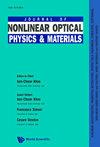新型稳定超宽带隙As2O3半导体材料
IF 2.3
4区 物理与天体物理
Q2 OPTICS
引用次数: 4
摘要
超宽带隙材料在深紫外光电子学以及下一代大功率和射频电子学中具有许多潜在的应用。通过基于密度泛函理论计算的第一性原理计算,我们证明了As2O3的体结构和单层结构具有优异的能量、力学和热稳定性。大块和单层的As2O3有两种不同的结构,即st1-As2O3和st2-As2O3。我们发现st1-As2O3和st2-As2O3单层和双层材料可以机械地从它们的块状材料中剥离,并且发现解理能值明显低于类似层状材料的解理能值。通过Perdew-Burke-Ernzerhof (PBE)和Heyd-Scuseria-Ernzerhof (HSE06)能带结构计算,我们发现As2O3的体层和单层结构表现出宽(PBE)和超宽(HSE06)的间接带隙。我们进一步评估了与As2O3层厚相关的带隙,发现带隙随着st1-As2O3和st2-As2O3层数的增加而均匀减小。我们的发现证明了As2O3结构在未来超宽带隙半导体电子器件设计中的潜力。本文章由计算机程序翻译,如有差异,请以英文原文为准。
New stable ultrawide bandgap As2O3 semiconductor materials
Ultrawide band gap materials have numerous potential applications in deep ultraviolet optoelectronics, as well as next-generation high-power and radio frequency electronics. Through the first-principles calculations based on density functional theory calculations, we demonstrate that the As2O3 bulk and monolayer structures have excellent energetic, mechanical, and thermal stabilities. The bulk and monolayer of As2O3 come in two distinct structures, namely st1-As2O3, and st2-As2O3. We show that the st1-As2O3 and st2-As2O3 monolayer and bilayer could be mechanically exfoliated from their bulk material and found that the cleavage energy values are significantly lower than those reported for similarly layered materials. By performing Perdew–Burke–Ernzerhof (PBE) and Heyd–Scuseria–Ernzerhof (HSE06) band structure calculations, we found that the bulk and monolayers of As2O3 structures exhibit wide (PBE) and ultra-wide (HSE06) indirect band gaps. We further evaluate the As2O3 layered thickness-dependent band gaps and found that band gap decreases uniformly as the number of st1-As2O3 and st2-As2O3 layers increases. Our findings demonstrate the potential of the As2O3 structures for the future design of ultra-wide band gap semiconductor electronic devices.
求助全文
通过发布文献求助,成功后即可免费获取论文全文。
去求助
来源期刊
CiteScore
3.00
自引率
48.10%
发文量
53
审稿时长
3 months
期刊介绍:
This journal is devoted to the rapidly advancing research and development in the field of nonlinear interactions of light with matter. Topics of interest include, but are not limited to, nonlinear optical materials, metamaterials and plasmonics, nano-photonic structures, stimulated scatterings, harmonic generations, wave mixing, real time holography, guided waves and solitons, bistabilities, instabilities and nonlinear dynamics, and their applications in laser and coherent lightwave amplification, guiding, switching, modulation, communication and information processing. Original papers, comprehensive reviews and rapid communications reporting original theories and observations are sought for in these and related areas. This journal will also publish proceedings of important international meetings and workshops. It is intended for graduate students, scientists and researchers in academic, industrial and government research institutions.

 求助内容:
求助内容: 应助结果提醒方式:
应助结果提醒方式:


